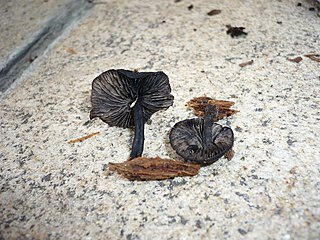
Moniliophthora perniciosa is a fungus that causes "witches' broom disease" (WBD) of the cocoa tree. T. cacao a tropical tree with seeds that are processed into cocoa (=cacao) products. This pathogen is currently limited to South America, Panama and the Caribbean, and is perhaps one of the best-known cocoa diseases, thought to have co-evolved with cocoa in its centre of origin.

Collybia is a genus of mushrooms in the Tricholomataceae family. The genus has a widespread but rare distribution in north temperate areas, and contains three species that grow on the decomposing remains of other mushrooms.
Palaeocephala is a genus of fungi. This is a monotypic genus, containing the single species Palaeocephala cymatelloides, described by Rolf Singer in 1962. According to the Dictionary of the Fungi, the genus is classified in either the Marasmiaceae or Physalacriaceae families; the taxonomical database MycoBank includes it in the Marasmiaceae.

Anthracophyllum is a genus of fungi in the family Marasmiaceae in the order Agaricales. The genus is widespread in tropical regions, and contains 10 species.

Crinipellis is a genus of fungus in the family Marasmiaceae. The genus has a widespread distribution and contains about 65 species. It was circumscribed by French mycologist Narcisse Théophile Patouillard in 1889.
Deigloria is a genus of agaric fungus in the family Marasmiaceae. Described by mycologist Reinhard Agerer in 1980, the genus contains 10 species that are widespread in neotropical areas. The generic name derives from the Latin words Deus (God) and gloria (glory).
Fissolimbus is a fungal genus in the family Marasmiaceae. This is a monotypic genus, containing the single species Fissolimbus fallaciosus, found in Papua New Guinea. The genus and species were described as new to science in 1979.
Glabrocyphella is a genus of fungi in the Marasmiaceae family. The widespread genus contains 13 species.

Gymnopus is a genus of fungus in the family Marasmiaceae. The genus has a widespread, cosmopolitan distribution and contains about 300 species.

Hydropus is a genus of fungi in the family Marasmiaceae. The widespread genus contains about 100 species, especially in tropical areas, but is not well represented in temperate regions. About 15 taxa are found in Europe; H. floccipus has the widest distribution in western Europe. Hydropus was circumscribed by Rolf Singer in 1948. Species in the genus have fruit bodies with caps that are mycenoid, collybioid, or omphaloid in form. Most species occur in tropical and subtropical regions, where they grow as saprobes on rotting wood, forest litter, and mosses. Generally, most Hydropus species are rare, and several are known only from the type collection, including H. conicus, H. moserianus, H. nitens, and H. paradoxus.
Pseudotyphula is a genus of fungus in the Marasmiaceae family. The genus is monotypic, containing the single species Pseudotyphula ochracea, found in North America. The genus was circumscribed by British mycologist E.J.H. Corner in 1953.
Skepperiella is a genus of fungus in the Marasmiaceae family. The widespread genus contains four species.
Stipitocyphella is a fungal genus in the family Marasmiaceae. It is a monotypic genus, containing the single species Stipitocyphella keniensis, from Kenya.
Hymenogloea is a fungal genus in the family Marasmiaceae. The genus is monotypic, containing the single species Hymenogloea riofrioi, found in tropical America.

Crinipellis zonata, commonly known as the zoned Crinipellis or the zoned-cap Collybia, is a species of gilled mushroom in the Marasmiaceae family. Though considered a little brown mushroom of unknown edibility, it is distinctive because of its thick covering of coarse hairs, and differentiated from other members of Crinipellis by its slightly larger cap size, which reaches up to 25 mm (1.0 in) in diameter. The white gills on the underside of the cap are crowded closely together, and are free from attachment to the stem. Saprobic, it grows on the dead wood of deciduous trees from late summer to autumn. The fungus is found commonly in eastern North America, but has also been collected in Portugal and Korea. The variety C. zonata var. cremoricolor, found in eastern North America, may be distinguished microscopically by its longer spores.

Setulipes was a proposed genus of fungi in the Marasmiaceae family. This group of mushrooms, described by the Czech mycologist Vladimír Antonín in 1987, has a widespread distribution in north temperate areas, and would contain about 25 species.
Trichoderma ovalisporum is a species of fungus. It has ovoidal conidia and a fast rate of growth at 30 °C. It has been considered for its biocontrol potential against Moniliophthora roreri.
Trichoderma paucisporum is a species of endophytic fungus in the family Hypocreaceae. It was first isolated in Ecuador from cacao pods infected with frosty pod rot, Moniliophthora roreri. It produces a volatile antibiotic that inhibits development of M. roreri.









